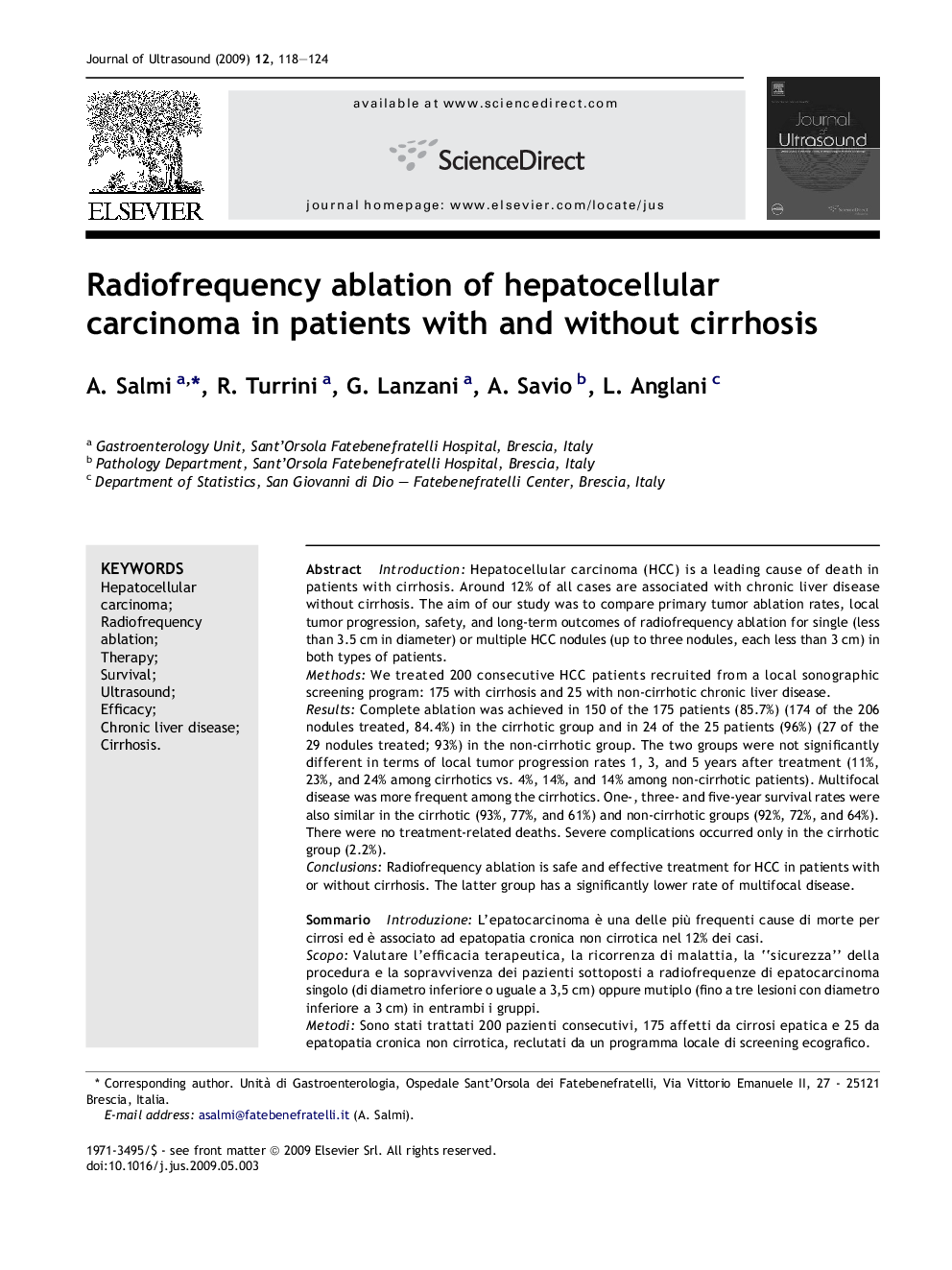| Article ID | Journal | Published Year | Pages | File Type |
|---|---|---|---|---|
| 4236921 | Journal of Ultrasound | 2009 | 7 Pages |
IntroductionHepatocellular carcinoma (HCC) is a leading cause of death in patients with cirrhosis. Around 12% of all cases are associated with chronic liver disease without cirrhosis. The aim of our study was to compare primary tumor ablation rates, local tumor progression, safety, and long-term outcomes of radiofrequency ablation for single (less than 3.5 cm in diameter) or multiple HCC nodules (up to three nodules, each less than 3 cm) in both types of patients.MethodsWe treated 200 consecutive HCC patients recruited from a local sonographic screening program: 175 with cirrhosis and 25 with non-cirrhotic chronic liver disease.ResultsComplete ablation was achieved in 150 of the 175 patients (85.7%) (174 of the 206 nodules treated, 84.4%) in the cirrhotic group and in 24 of the 25 patients (96%) (27 of the 29 nodules treated; 93%) in the non-cirrhotic group. The two groups were not significantly different in terms of local tumor progression rates 1, 3, and 5 years after treatment (11%, 23%, and 24% among cirrhotics vs. 4%, 14%, and 14% among non-cirrhotic patients). Multifocal disease was more frequent among the cirrhotics. One-, three- and five-year survival rates were also similar in the cirrhotic (93%, 77%, and 61%) and non-cirrhotic groups (92%, 72%, and 64%). There were no treatment-related deaths. Severe complications occurred only in the cirrhotic group (2.2%).ConclusionsRadiofrequency ablation is safe and effective treatment for HCC in patients with or without cirrhosis. The latter group has a significantly lower rate of multifocal disease.
SommarioIntroduzioneL'epatocarcinoma è una delle più frequenti cause di morte per cirrosi ed è associato ad epatopatia cronica non cirrotica nel 12% dei casi.ScopoValutare l'efficacia terapeutica, la ricorrenza di malattia, la “sicurezza” della procedura e la sopravvivenza dei pazienti sottoposti a radiofrequenze di epatocarcinoma singolo (di diametro inferiore o uguale a 3,5 cm) oppure mutiplo (fino a tre lesioni con diametro inferiore a 3 cm) in entrambi i gruppi.MetodiSono stati trattati 200 pazienti consecutivi, 175 affetti da cirrosi epatica e 25 da epatopatia cronica non cirrotica, reclutati da un programma locale di screening ecografico.RisultatiÈ stata ottenuta una risposta completa in 150 dei 175 pazienti (85,7%) (174/206 noduli, 84,4%) nel gruppo dei cirrotici, in 24 dei 25 pazienti (96%) (27/29 noduli, 93%) nel gruppo dei non cirrotici.Il tasso di recidiva locale a 1, 3, 5 anni dalla procedura non era differente tra i cirrotici (11, 23 e 24% rispettivamente) e i non cirrotici (4, 14 e 14%), mentre il tasso di malattia multicentrica era più elevato nei cirrotici.Il tasso di sopravvivenza a 1,3,5 anni non era differente tra il gruppo dei cirrotici (93, 77 e 61% rispettivamente) e dei non cirrotici (92,72 e 64% rispettivamente). Nessun paziente è deceduto a causa del trattamento e solo il 2,2% dei pazienti nel gruppo dei cirrotici ha presentato complicanze maggiori.ConclusioniLa termoablazione con radiofrequenze è una tecnica efficace e affidabile in pazienti con o senza cirrosi; nei pazienti senza cirrosi l'insorgenza di malattia multicentrica è significativamente inferiore.
